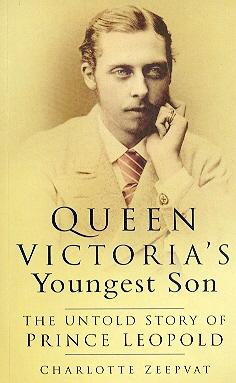
When contacting us by e-mail, correspondents are asked to include their name and full postal address and, when providing information, to quote exact book and magazine sources. The word ‘chess’ needs to appear in the subject-line or in the message itself.
| First column | << previous | Archives [17] | next >> | Current column |

Charlotte Zeepvat’s biography Queen Victoria’s Youngest Son (page 129 of the 2005 edition) has the following brief reference to chess:
‘In February 1874 he was elected to membership of the University Chess Club, because he was often seen playing chess in the coffee room at the Union.’
And from page 296 of A Century of British Chess by P.W. Sergeant (London, 1934):
‘It may be mentioned that the Oxford president at this time was H.R.H. Prince Leopold (afterwards created Duke of Albany), who was attached to Christ Church, and in the previous year had been invited by the club to become an honorary member, but had preferred to join in the ordinary maner. He was elected president in the summer of 1874, but took part in no matches, though he participated in a handicap tournament among the members. He is mentioned as a pupil of H.E. Bird, or at least as playing with him occasionally.’
Confirmation of these various statements is sought.
C.N. 2510 (see pages 261-262 of A Chess Omnibus) quoted a remark by W. Wayte (in The Field, 15 August 1874, page 174) that ‘one of the Prince Leopold’s games at chess has been published’, and below we give, from pages 249-250 of the April 1884 Chess Monthly, ‘the only game of his on record’:
Horace Curzon Plunkett and C. Tracey – Prince Leopold and Walter Parratt1 e4 e5 2 f4 exf4 3 Nf3 g5 4 d4 g4 5 Nc3 gxf3 6 Qxf3 Qh4+ 7 g3 fxg3 8 hxg3 Qf6 9 Bf4 Bb4 10 O-O-O Bxc3 11 Qxc3 Qc6 12 Qb3 Qb6 13 Qf3 Na6 14 Be5 f6 15 Qh5+ Ke7
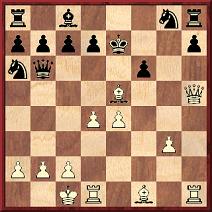
16 Bc4 d5 17 exd5 fxe5 18 Qxe5+ Kd8 19 Qxh8 Qg6 20 Rxh7 Bf5 21 Rg7 Qh6+ 22 Qxh6 Nxh6 23 Rh1 Ke8 24 Rxh6 K0f8 25 Rh8+ Kxg7 26 Rxa8 and wins.
The Prince (also known from 1881 onwards as the Duke of Albany) was a prominent chess patron during his short life (1853-84), and the London, 1883 tournament was held under his patronage. Page x of the tournament book, which was dedicated to him, recorded that ‘H.R.H. The Duke of Albany graciously consented to become the Patron of the undertaking’.
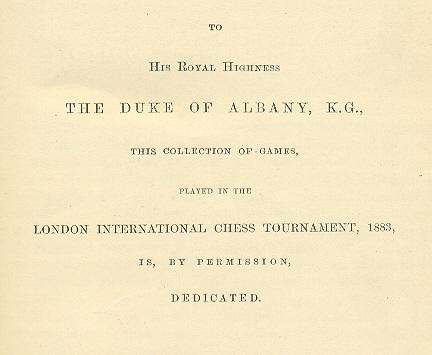
Page 235 of the April 1884 Chess Monthly reproduced an extract from a speech delivered ‘at the Birkbeck Institution Chess class in 1879’:
‘Now, is it not true that in life, as in chess, it is often the opening, and the opening only, which is under your own control? Later in the game the plans and wishes of others begin to conflict unpleasantly with our own. Sometimes it is as much as we can do to avoid being checkmated altogether, but for the first few moves we are free. We can deploy our pieces to the best advantage. We can settle on the line of action which best suits our powers, and we may sacrifice a pawn or a piece so as to gain at once a position which may give us a decided advantage throughout the whole game. Does not this, too, remind us of real life? Must we not sometimes be ready to sacrifice some form of present pleasure or profit to gain that which self-indulgence could never have won? Among the bright young faces around me many have known what it is to labour against the grain- to begin a lesson when they rather have gone to a theatre; to finish it when they would rather go to bed; and such efforts of self-denial and conscientiousness form at least one-half of the benefit of education. It is a great benefit to fight for knowledge, to suffer for her, and to make her our own.’
The latter part of this speech (i.e. without any reference to chess) was quoted on page 128 of Charlotte Zeepvat’s book, being taken from page 318 of The Graphic, 5 April 1884. In chess circles, however, it was the first sentence which became well-known at the time. The following appeared on page 146 of the April 1884 BCM:
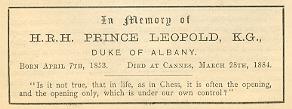
The quote also appeared in a feature on the Duke on pages 140-141 of Chess Fruits by T.B. and F.F. Rowland (Dublin, 1884), which included an acrostic poem dedicated to Duke.
The friendship between Prince Leopold and John Ruskin (1819-1900) was discussed extensively in Queen Victoria’s Youngest Son by Charlotte Zeepvat, and this prompts us to cite some references to Ruskin which we have found in chess literature:
‘Chess, on the contrary, I urge pupils to learn, and enjoy it myself, to the point of its becoming a temptation to waste of time often very difficult to resist; and I have really serious thoughts of publishing a selection of favourite old games by chessplayers of real genius and imagination, as opposed to the stupidity called chessplaying in modern days. Pleasant “play”, truly! in which the opponents sit calculating and analysing for 12 hours, tire each other nearly into apoplexy or idiocy and end in a draw or a victory by an odd pawn.’
The full text was also given on pages 172-173 of The Chess Reader by J. Salzmann (New York, 1949).
‘In painting and poetry the workers scorn analysis, and the best work defies it, and, so far as chess is capable of analysis, it is neither art nor play.’
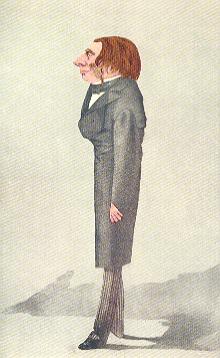
John Ruskin (Vanity Fair)
‘Capt. Kennedy’s games and Mr Cochrane’s always amuse me and, I believe, with some of Mr Barnes’s, some of Morphy’s, and a sprinkling of Anderssen, will be very acceptable to players of my own species, and to young people who have other work than chess on hand.’
‘Here we think of Ruskin as a votary of chess – for he was an enthusiastic lover of the game – that is of chess of a sort, for he would have none of the pawn-gaining, wood-shifting, snail-creeping chess. He loved only the “grand style”, the sweeping majesty of a game by Morphy or the glittering beauty of a blindfold gem by Blackburne. He regarded chess from its artistic side – as indeed was to be expected of him. He never played chess in public or in any club, reserving it as a relaxation in his own home; but he took great interest in published games of a brilliant description, and was specially fond of Bird’s bright games of years ago, and on more than one occasion wrote to that master.’
‘Many people may have overlooked the fact that Ruskin loved the game of chess. Some of his letters reveal this interest. He was at one time a constant visitor to Maskelyne & Cooke’s entertainment, where he once played a game with “Psycho”, and he tried his skill against other chess automata. “Indeed, it was a matter of pride to him”, say his latest editors, “that he had obtained more than one victory over the famous Mephisto at the time when it was performing at the Crystal Palace with considerable éclat. He was a Vice-President of the British Chess Association.’
‘That Mr Ruskin’s aversion to dull and colorless chess arose from a genuine love of the game is accentuated by a passage in a letter from him, dated Brantwood, Coniston, 11 July 1885:
“I am usually very thankful”, he wrote, “to escape from them (his books) to chess. Though I have no claims whatever to be ranked among chessplayers any more than among painters properly so called, I enjoy chess as I do drawing, within my limits – and if, indeed, some time you condescended to beat me a game by correspondence it would be a great delight to me.”’
‘That Ruskin’s role as chess critic, though “clouded by enthusiasm” is exempt from even a modest knowledge of the game is made clear at the outset by his notes upon the openings. Both the Centre Counter Gambit and the Falkbeer he regards as “unusual”, which epithet he gives to White’s 3 Bb5 (Ruy López). The “Cunningham” is “most busy and curious”. As to the “Evans’” (although so entitled throughout the book) he says, “This I shall call the Bishop’s Gambit, the knight’s pawn being the bishop’s prey”.
As for the games, it is palpable that Ruskin favoured the “knock-about” school in which whoever first flukes a mate wins. The working-out of an endgame is repellent to him, and an exchange of queens “spoils the game at once”. He is quite unable to comprehend the progressive development of a combination the issue of which shall be simple and conclusive, and in recording the boredom that such processes inflict he has no suspicion that his mental grasp is at fault.’
There followed two pages of examples of Ruskin’s comments on a number of Morphy games and positions.
‘I’ve only begun saying what I have to say about the temper of chess. I think, in general, great players should never give odds but openings, leaving weak points on purpose to show, or find, new forms of the game, and should name the move after which they mean to play their best. Above everything, I want to know, in the great games, where either of the players is first surprised. Andersen (sic) and Morphy seem to me the only ones that never are – they are only beaten by getting tired and making mistakes, or Morphy in trying a new opponent’s style.’
Goulding Brown pointed out that page xviii of Chess History and Reminiscences by H.E. Bird (London, 1893) recorded that Bird had received 28 letters from Ruskin since 1884. An excerpt from one of them, dated 15 December 1886, was cited in the BCM article:
‘I find Blackburne’s games intolerably and unpardonably dull – and am more and more set on my old plan of choosing a set of beautiful games – Cochrane, Kennedy, Barnes, Macdonnel [sic] and the like – with some of your lovely short ones. I find even Morphy a little dull in his security!’
Numerous other chess-related quotes from Ruskin’s pen were presented by Goulding Brown, who concluded:
‘The upshot of it all is that Ruskin loved chess as a game and an art, but hated it as a science.’
Another group photograph for readers to ponder. A caption will be provided later on.
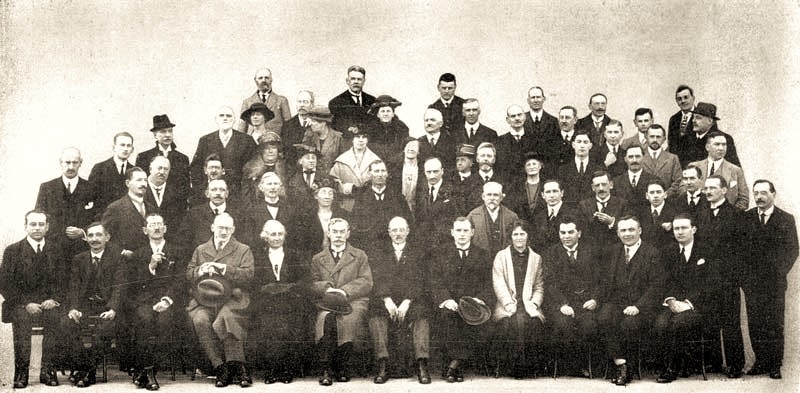
In C.N. 3815 a correspondent asked for information about the game Rossolimo v Livingstone, New York, 1961, which went: 1 e4 d5 2 exd5 Qxd5 3 Nc3 Qa5 4 d4 Nf6 5 Nf3 Bg4 6 h3 Qh5 7 Be2 Nc6 8 O-O Bxh3 9 gxh3 Qxh3 10 Ng5 Qh4 11 d5 Ne5 12 Bb5+ c6 13 dxc6 bxc6 14 Nd5 O-O-O 15 Ba6+ Kb8 16 Bf4 Rxd5 17 Bxe5+ Ka8
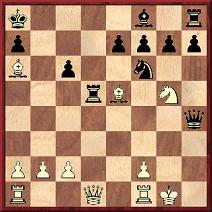
18 c4 Qxg5+ 19 Bg3 Rxd1 20 Raxd1 Nd5 21 cxd5 c5 22 b4 c4 23 Rd4 e5 24 dxe6 Bxb4 25 Rd7 Rb8 26 Rfd1 Be7 27 exf7 c3 28 f8(Q) Resigns.
Now Jack O’Keefe (Ann Arbor, MI, USA) writes:
‘I have part of an answer to the mystery of the Rossolimo v Livingstone game. It was published in B.H. Wood’s column in the Illustrated London News, 30 December 1961, page 1160. His introduction to the game was:
“N. Rossolimo, born in Odessa of Greek parentage, wandered to Prague, then Paris. He is now in New York. Here is a real Wild West game he played there recently.”
Wood wrote nothing further about the occasion or the opponent. However, Chess Life for 1961 gives no tournaments in which Rossolimo took part, and it seems likely that the game was not played in a serious event.’
Peter Treffert (Lorsch, Germany) sends the following game from a simultaneous exhibition (+23 –10 =7):
Alexander Alekhine – Max Eisinger1 e4 c5 2 Nf3 Nc6 3 d4 cxd4 4 Nxd4 Nf6 5 Nc3 d6 6 Be2 g6 7 O-O Bg7 8 Nb3 O-O 9 Be3 Be6 10 f3 Ne5 11 Bd4 Nc4 12 Rb1 Qd7 13 g4 b5 14 Qe1 a5 15 h3 a4 16 Nd2
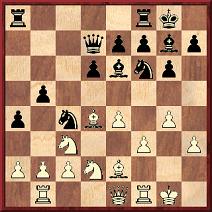
16...Nxe4 17 Bxg7 Nexd2 18 Bxf8 Nxb1 19 Bh6 Nxc3 20 Qxc3 f6 21 b3 axb3 22 axb3 Ne5 23 h4 Rc8 24 Qd2 Qc6 25 Bd1 Bd5 26 Qe3 Ra8 27 Bf4 Ra1 28 g5 Bxf3 29 Bxe5 Rxd1 30 Rxd1 Bxd1 31 Bb2 Qc5 32 Bd4 Qd5 33 gxf6 e5
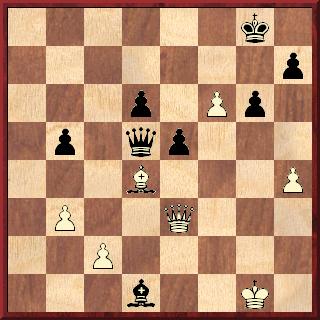
34 c3 Qf7 35 Qd3 exd4 36 Qxd1 Qxf6 37 cxd4 Qxh4 38 Qd3 Qg4+ 39 Kh2 Qf5 40 Qe3 Kf7 41 Qc3 Qf4+ 42 Kg2 Qe4+ 43 Kf2 h5 44 Qc7+ Qe7 45 Qc6 Qh4+ 46 Ke3 Qe1+ 47 Kf4 Qf2+ 48 Kg5 Qe3+ 49 Kh4 Qxd4+ 50 Kg3 Qe5+ 51 Kf3 Kf6 52 Qa8 Kg5 53 b4 h4 54 Kg2 Qe2+ 55 Kh3 Qf1+ 56 Kh2 Qf4+ 57 Kg2 Kg4 58 Qc8+ Qf5 59 Qc6 h3+ 60 Kg1 h2+ 61 White resigns.
Source: Max Eisinger 1909-1989 by Harald Klingenberg
(Karlsruhe, 2005) – game seven in the Appendix.
C.N. 1180 gave a game lost by Filiberto Terrazas against Fidel Castro in Havana, 1966, from page 323 of the November 1966 Jaque Mate: 1 e4 e5 2 f4 exf4 3 Nf3 Bd6 4 d4 h6 5 e5 Bb4+ 6 c3 Ba5 7 Bxf4 g5 8 Bg3 Qe7 9 Be2 d6 10 exd6 cxd6 11 Qa4+ Nc6 12 d5 Bd8 13 dxc6 b5 14 Qxb5 a6 15 Qa4 g4 16 c7+ Bd7 17 c8(Q) Rxc8 18 Qd4 gxf3 19 Qxh8 Qxe2 mate.
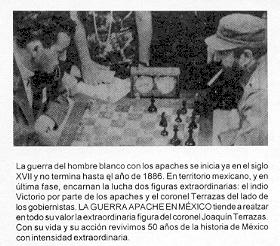
The above photograph, taken during play, was on the back-cover of Terrazas’ book La guerra apache en México, which was first published in 1972.
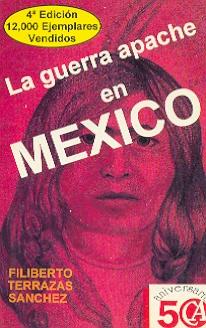
As mentioned on pages 8-9, in 1962 Terrazas wrote El águila caída, a biographical novel concerning Carlos Torre.
C.N. 3991 asked for particulars about the statement by Chernev on page 47 of Wonders and Curiosities of Chess (New York, 1974) that ‘On a wager, C.F. Burille solved 62 chess problems in one hour.’
We now note that on page 226 of the October 1914 American Chess Bulletin C.C. Lee wrote:
‘As a solver Mr Burille had few equals. It is recalled that on one occasion he undertook to solve 60 two-movers in an hour on a small wager, and accomplished the task with five minutes to spare.’
The entry for Burille in Jeremy Gaige’s Chess Personalia recorded that he was born in Boston on 30 August 1866, whereas page 209 of Chess: Man vs Machine by B. Ewart (London, 1980), which had the following photograph from the Cleveland Public Library, described Burille as ‘a Bostonian born in Paris’.
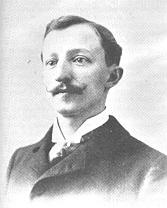
Constant Ferdinand Burille
Support for Ewart’s version is provided by a news item on pages 254-255 of La Stratégie, 15 August 1888:
‘Le Times Democrat de la Nouvelle Orléans publie une lettre de M. Young précédent rédacteur du Boston Post qui signale la présence à Boston d’un jeune homme de 22 ans, parisien de naissance, jouant aux échecs depuis deux ans seulement, qui est le champion du Club. M. Young après avoir constaté qu’il a été battu par 13 parties contre une gagnée et une nulle, émet l’opinion que ni M. Steinitz ni M. Mackenzie ne pourront vaincre son jeune champion qui s’appelle Constant-Ferdinand Burille.’
Franklin K. Young gave a number of games by Burille in his book The Grand Tactics of Chess (Boston, 1905).
We present a digest of items from old chess literature about connections between chess and William Shakespeare.
‘Mr Staunton has evidently edited the works of the great dramatist in a very loose way. If this were not the case, we should have had somewhere in the bulky volume some notice of the chess life of Shakespeare. That he must have possessed a large knowledge of the game is evident from the hastiest perusal of his divine writings. He speaks in Winter’s Tale of an “unkind mate” – and what chessplayer, who has been suddenly and ruthlessly mated at a moment when victory seemed about to perch upon his banner, does not know what that means? In some Morphic Evans, when towards the close of the encounter, the Amazonian queen, the militant bishop and the gallant knight bear bravely down upon the unlucky opposing king, what better describes the terminating struggle than the “warlike mate” mention in Henry VI? In the same play we find an allusion to an “unknown mate” or a mate given by one skilled in the written theories of chess. When, in King Lear, the renowned playwright speaks of “one self-mate” he unfortunately neglected to tell us to what particular suicidal problem he refers. How naturally Antipholus of Syracuse, in the Comedy of Errors, apparently wrought up into an insane excitement by the disastrous result of a combat on the sable and silver field of chess, exclaims that he is “not mad, but mated”. In a pretty punning way, in another play, Elinor accuses Constance of wishing Arthur to be King, in order that she may “be a queen and check the world”. Leontes of Sicily found that the “loss of his most precious Queen” was a thing to be “lamented”, as many men have done in these later times. The expression of Suffolk, “My King! tush! that’s a wooden thing!” shows what the material of chessmen was in the elder period of English chess history. In King John we discover a sort of proverbial reference to a close and crowded game in the comparison, “To lie like pawns, locked up”. In The Taming of the Shrew Katharine says,
“I pray you sir, is it your will,
To make a stale of me amongst these mates?”And we might multiply quotations to prove how intimately the dramatist understood the nature of the game and its cultivators. We have had volumes on Shakespeare as a lawyer, and Shakespeare as a moralist. Pray, Mr Commentator Staunton, will you give us a tome on Shakespeare as a chessplayer?’
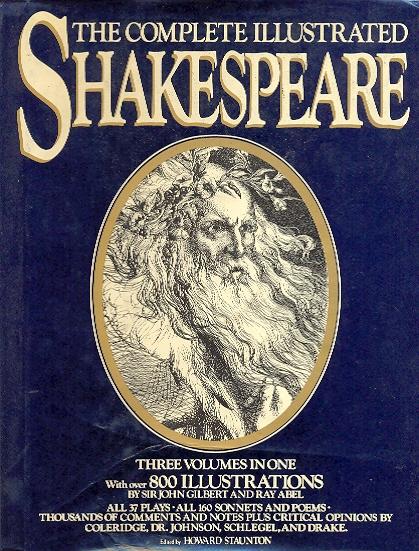
‘“Though it has been surmised”, says George H. Ely, “that the scene in The Tempest in which Ferdinand and Miranda are discovered playing chess was introduced because Ferdinand was Prince of Naples, and in Shakespeare’s time Naples was the headquarters of chess play, there is no necessity for supposing that the dramatist had any purpose other than that of showing the lovers in a pretty and engaging attitude. It is notable, however, that nowhere else does Shakespeare make any direct reference to chess. Unlike Bacon and many other writers, he never uses its term by illustration or metaphor. The inference which these facts seems to warrant is that for Shakespeare the game had no great amount of attraction.”’
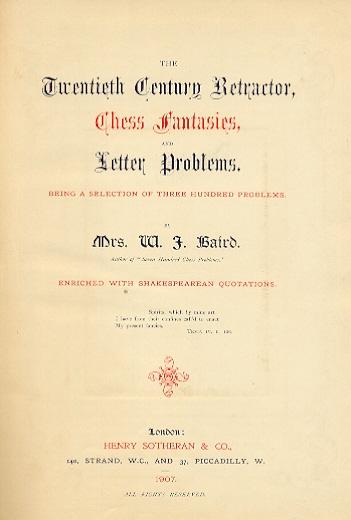
On page 301 of the July 1916 Chess Amateur P.H. Williams wrote:
‘I think it was Mrs Baird who did more to search Shakespeare for accidental (or deliberate) reference to chess, since all her retractors had Shakespearean mottoes, and her knowledge of the Avonian bard was obviously extensive. Her example was followed by other composers of retractors, who considered such positions would be incomplete without some reference to the poet.’
‘... The artistic conscience sometimes makes him who has it a coward – or, let us say, a Hamlet of the chess board.
I wonder if Hamlet was a chessplayer. From his character it seems indeed likely. If he was, he probably played a weak but imaginative game, with a craving to improve upon the best move and therefore often missing it.
Hamlets of the chess board are frequent types. Once in the meshes of combination they lose themselves in its intricacies, and evolve ideas that are so infinitely subtle that they have no vitality. Then is the moment when fate, usually with a somewhat brutal, matter-of-fact blow, wakes them out of their dreams.’
Lasker’s remarks were quoted on page 152 of the July 1908 American Chess Bulletin (courtesy of The Australasian) and on page 108 of the May 1911 American Chess Bulletin.
‘... an original painting of Shakespeare, for which it is said that the late J.P. Morgan was prepared to offer $1,000,000 on proof of its authenticity, is now in possession of Mrs Catherine de Heyman, of 269 Carlton Avenue, Brooklyn. Its history has been thoroughly investigated, and it is said that the possessor now has absolute proof that the painting is genuine ...The picture is 30¾ inches in height and 38 inches wide and is painted on chalked linen, which was stretched over a frame. It is full of slits and cracks but is still fresh and beautiful in color. It represents Shakespeare playing a game of chess with his friend Ben Jonson, who was also a dramatist.
Investigation by the learned Dr Paul Wislicenus of Darmstadt, a member of the German Shakespeare Society, has resulted in ascribing the de Heyman painting to the brush of Karel van Mander as being one of his best works.
He says “The picture shows the hand of a master, at the turn of the sixteenth and seventeenth centuries. The style of painting betrays the Titian school, then approaching the rococco. The composition is that of the Netherlands ...”’
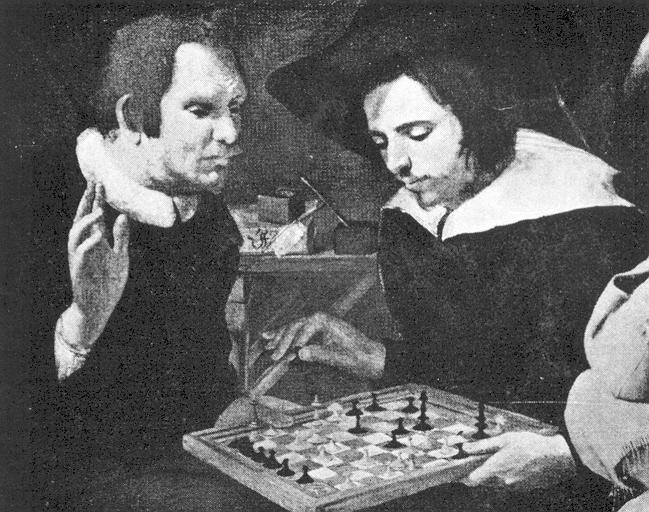
An attempt was also made to reproduce the position (although other proposals have been seen over the years):
‘White: B. Jonson
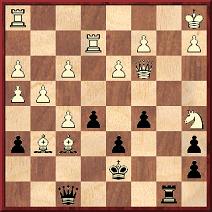
Black: W. Shakespeare
The bishop in the hand of the player takes the white queen mate.
(Position of white pawns is impossible.)
Shakespeare holds a black bishop in his right hand which he has taken from Black’s KKt5 square [sic]. Bishop takes queen mate. The mediaeval shapes of the white bishop at QB3, the black bishop and the white rook at Q7 are of interest.
The same designed bishops are given in the diagrams of the Alfonso Spanish 1283 Manuscript, and the double-headed rook appears in Caxton’s London 1480 edition.’
‘If “absolute proof” why did not the owner of the picture secure that million dollars? We are sorry to throw cold water on anything that ought to be true, but the authorities re Shakespeare would say that there is no picture in existence of Shakespeare playing at chess or any game, and never has been so far as can be known. Ditto Ben Jonson. Further, that there is no evidence of Shakespeare having ever been a chessplayer. Of course he knew what the game looked like, and must have known some chessplayers. He probably knew the names of the pieces and how they should be placed for play. He may have known the moves. Possibly he played the game occasionally. He shows us Ferdinand and Miranda playing at chess, and Miranda complains of an illegal move, which Ferdinand denies making. Otherwise there is no clear allusion to chess in all “Shakespeare”. There are several possible references, the most likely being the line “She shall be Queen, and check the world.” Probably this was a conscious reference to chess, the more so that the chess queen, in England, had not long had her full power of checking at long range. There are several cases of the word “mate” being used – as “mated and stark mad”. But the word in Shakespeare’s time, though obviously derived from “checkmate”, in the chess term, was often used by non-chessplayers, with the meaning of “beaten”, “confused”, “bewildered” or “amazed”.’
The above item had also been quoted on page 12 of the October 1915 Chess Amateur. Page 44 of the November 1915 issue gave information about the painting and the diagram, courtesy of the Good Companion Problem Club Bulletin.
‘Much of the terminology of chess has passed into the language of everyday speech. No-one whose intellectual development has progressed beyond the point necessary to a perfect comprehension of the elementary principles of “Marbles” would fail to understand the meaning of such a word, for instance, as “Check” when used to describe some annoying situation in one’s daily life; nor is it possible to imagine any similar difficulty occurring to anyone in Shakespeare’s day when confronted with an idiom borrowed from the nomenclature of a game that was already centuries old; with a literature of its own extending back to ages of fable and myth.’
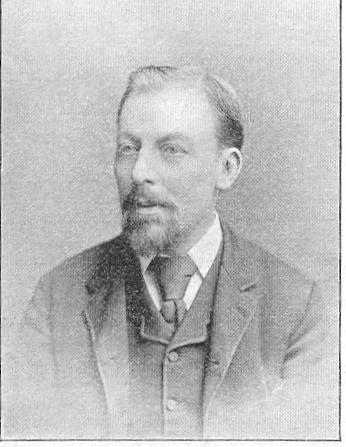
William Shelley Branch
‘I have seen a small reproduction of the alleged Shakespeare-Jonson picture, and am interested. It looks old and good. I think the artist meant to represent Shakespeare and Jonson. If so the question is, was the picture printed in Shakespeare’s time?
Up to date I doubt it.
If the picture were accepted by all authorities as being what it claims to be it would be very strong evidence – taken with other things – that Shakespeare and Jonson could play chess, and sometimes did.
A possibility is that the picture was painted in 1603 and signed as stated (though signing at that period was not usual) but had no connection with Shakespeare or Jonson. The likeness may be accidental. The players may have been two Dutchmen.’
‘Only one who knew the move and power of the chess queen would have written this line.
... I do not suppose that Shakespeare was a chess expert, but for the reason I have given, and a few others, I believe he could play chess. He introduces the game into one play, The Tempest. He knew all sorts and conditions of men, many of them men of culture. He had had a good education himself and was a very well-read man. Among his friends and acquaintances there must have been many who played chess. The game was then more widely known and more popular, in proportion to population, than it has been since Shakespeare’s time. It went down very much with the rise of Puritanism and the Civil War, followed by a greater amount of card-playing and many other distractions later.’
Also on page 205 H.M. Holgate stated regarding the painting: ‘Personally, I am inclined to believe that this “old-master” will turn out to be a “fake”.’
‘The inscription on the portrait proves to the entire satisfaction of Dr Wislicenus that the chess game refers to the famous “Stage Quarrel” and, consequently, to Troilus and Cressida.
“We have such a complete agreement between Mander’s picture and Shakespeare’s genuine death mask”, writes Dr Wislicenus, in a private report comprising 100 typewritten pages in the possession of Mrs de Heyman, “that the fact of Mander’s having painted the poet from the life, either in Holland or in England – probably the latter – is proved beyond the possibility of doubt.”
The account of how the picture came into the possession of the de Heyman family was related the other day to a representative of the New York Times by the son, Frank de Heyman. His father, Frank de Heyman, a real estate operator and lover of art, bought the picture in 1903 or 1904 from an art dealer in New York City while the family was spending the summer in the Catskills. Its previous owner was Colonel Miller, who paid $18,000 for it in 1878 and who died at Mahwah, NJ in 1885. In a fire at the Miller home the documents accompanying the picture were destroyed.
The elder Mr de Heyman felt convinced of the picture’s historic value and made attempts to ascertain its real significance in the world of art, but had not made any noteworthy discoveries when he died in 1912. The brothers, Neville and Frank, decided to take it to Europe for expert testimony as to its authenticity, and Neville left New York in July 1912. He visited his uncle, Adolph von Heyman, in Bremen, by whom he was introduced to Dr Wilhelm Bode, Chief Director of the Berlin Museums. Dr Bode advised Mr de Heyman to consult a Shakespearean authority, with the result that a visit was made to the home of Dr Paul Wislicenus, who, after a study of the portrait and its inscriptions, pushed his hands through his hair and exclaimed, “I have never in my life seen anything like it. It is genuine. But now we must prove it.”
Dr Wislicenus spent the next two years in “toilsome work proving the genuineness of the picture “Ben Jonson and Shakespeare playing chess”.’
The article then quoted much detail from Dr Wislicenus’s report.
‘The Pittsburg[h] Gazette Times issued a special Shakespeare Chess column, and the enclosed soliloquy from Hamlet (recast to suit the problemist) is well worth reading.’ The parody began:
‘Two keys, or not two keys. That is the question.’
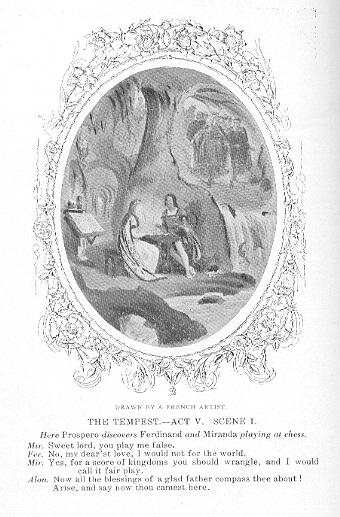
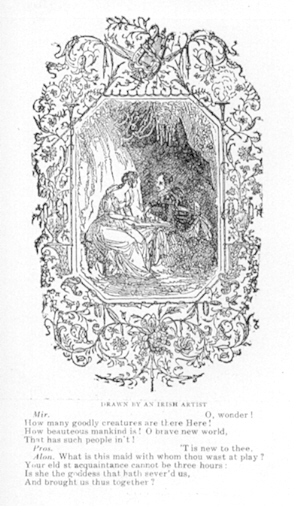
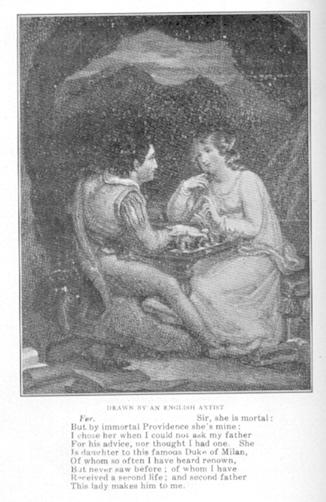
‘Altogether we consider there is sufficient evidence to show that W.S. must have known “the moves”. But whether he ever became a real chessplayer is uncertain.
He probably understood draughts, which was well known in and before his time. But we have found no mention of the game of draughts, dames or checkers in his works. He refers to backgammon, then known as tables, and one variety as tic-tac. And to billiards. Also to several card games. Some of the outdoor games are mentioned, but not cricket.’
‘In John’s time the queen did not “check the world” and was a weak piece, but Shakespeare either did not know or did not care about that. To him and his audience the chess queen was the same as now – had been in England for 60 years or more.’
Branch concluded:
‘The late Sir Sidney Lee, the biographer of Shakespeare, in correspondence with the present writer, agreed that the line in King John clearly referred to the chess queen, and showed that Shakespeare knew that the queen was, as now, the most powerful piece in the game. Knowing that, he would in all probability know the other moves.’
It may be noted that the above-quoted remark by Elinor in King John was annotated by Staunton as follows:
‘It has been doubted whether Shakespeare, who appears to have had cognizance of nearly every sport and pastime of his age, was acquainted with the ancient game of chess; we believe the present passage may be taken to settle the question decisively. The allusion is obviously to the queen of the chess board, which, in this country, was invested with those remarkable powers that render her by far the most powerful piece in the game somewhere about the second decade of the sixteenth century [sic].’
‘An exhibit which played an important part in adding to the attractiveness of the setting in which Capablanca displayed his prowess was a portion of the collection of unique chessmen owned by G.A. Pfeiffer of the Marshall Chess Club ...
Not far from the glass case, in which they were tastefully arranged, was hung a large oil painting of Shakespeare and Ben Jonson playing chess, owned by Frank de Heyman of Brooklyn, with the history of which readers of the Bulletin have already been made acquainted.’
In 1976 the alleged Shakespeare v Jonson painting was featured on a Nicaraguan postage stamp; see pages 57 and 92-93 of Persönlichkeiten und das Schachspiel by B. Rüegsegger (Huttwil, 2000). Any further information on this entire subject will be welcomed.
C.N. 3645 gave a photograph of prominent Belgian players, from page 33 of Chess Pie, 1927. The following page had pictures of five masters from Czechoslovakia:
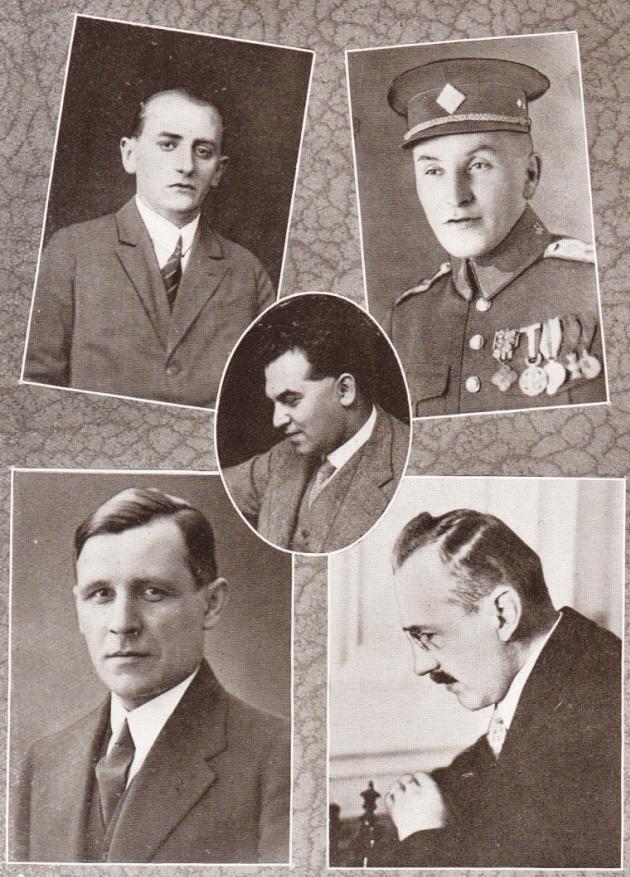
Clockwise from the top-left
corner: Karl Gilg, Karel Hromádka, Karel Treybal, Amos Pokorný.
Centre: Richard Réti
On page 113 of the April 1885 International Chess Magazine Steinitz wrote:
‘... the fearful misfortune which ultimately befell “the pride and sorrow of chess”, as Sheriff Spens justly calls Morphy, can only evoke the warmest sympathy in every human breast.’
That Spens wrote those oft-quoted words is well known, but what was the exact context of their original publication?
C.N. 4051 focussed on older chess literature, but Mark N. Taylor (Mt Berry, GA, USA) mentions a later article about the alleged Shakespeare-Jonson painting which is too good to be passed over: ‘Shakespeare’s Checkmate’ by Paul Leith on pages 8-13 of Chessworld, January-February 1964. Page 11 has a close-up of the board which readers may care to scrutinize:
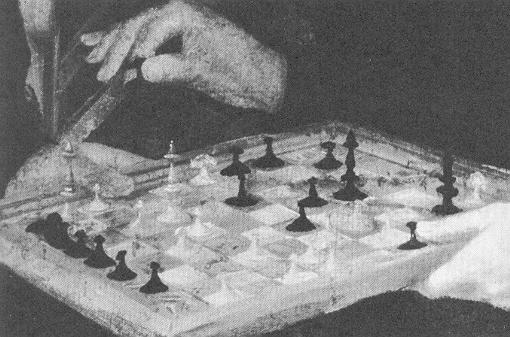
C.N. 3958 mentioned a claim that Adolf Hitler was a chessplayer. It emanated from one of the chess world’s least credible sources, yet we note that a reference to Hitler having possibly played chess with Lenin in Vienna in 1909 appeared on page 188 of Persönlichkeiten und das Schachspiel by B. Rüegsegger (Huttwil, 2000):
‘Die jüdische Malerin Emma Löwenstamm (1879-1941) brachte in Wien Hitler und Lenin zusammen, um sie gemeinsam zu malen. Sie lud beide ins Atelier von Julius von Ludassy ein. Im Donau-Kurier Ingoldstadt vom 19. July 1984 erwähnt Bernd Kallina in seinem Artikel die damals angefertige Zeichnung, wo Lenin auf der Rückseite die Worte “Lenin mit Hitler” hingeschrieben haben soll.’
Weiter wird erwähnt, dass sich beide 1909 in Wien getroffen und zusammen Schach gespielt haben ...’
No Hitler-Lenin illustration was provided in Rüegsegger’s book, but now Edward Hamelrath (Dresden, Germany) sends us the following picture:
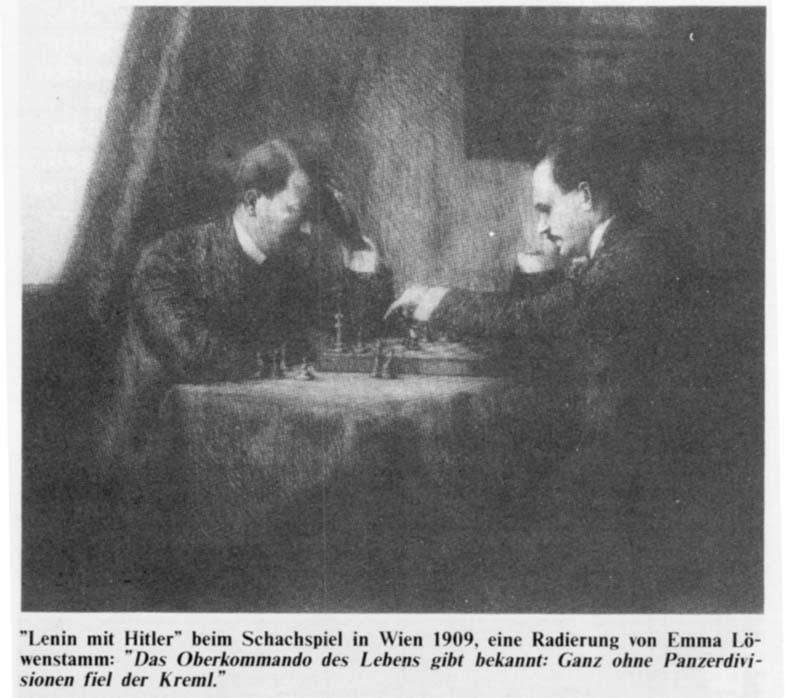
Our correspondent writes:
‘This etching comes from the extreme right-wing (and now defunct) magazine Europa Vorn (spezial Nr. 1/4. Quartal 1991), in an article entitled “Ungeist aus der Flasche” by a “v. Freisaß”. The article is just a rambling diatribe on twentieth-century world politics and makes no reference to the picture itself. It is not even clear exactly what the title is – either “Lenin mit Hitler” or “‘Lenin mit Hitler’ beim Schachspiel in Wien 1909”. (The “Das Oberkommando ...” comment under the picture was simply plucked out of the text.) In any case, the Hitler figure corresponds more to his appearance in the mid-1920s than in 1909.’
Further information on this bizarre matter will be welcomed. In the meantime readers are, of course, advised to view it with extreme circumspection.
An article by Kasparov on pages 104-105 of the 8/2005 New in Chess begins:
‘Botvinnik first captured the highest title in 1948, in the first true world championship event organized under FIDE – discounting their earlier amateur titles that were given little significance by contemporaries and even less by history. Prior to World War II FIDE failed to interest the champions, Alekhine publicly scoffing at Bogoljubow’s FIDE title.’
Page 130 of Bogoljubow – The Fate of a Chess Player by S. Soloviov (Sofia, 2004) states:
‘Efim Dmitrievich was invited to Holland in the spring [of 1928] for a match with Euwe. The idea was to determine the new FIDE world champion.
... the first world championship for amateurs was played in Paris in 1924 and the Latvian master Mattison won it. He was not universally acknowledged at all and FIDE decided to organize another competition – a match for the title of FIDE champion. ... There were not many people, though, who believed that Euwe had any chances of success. Still, he was leading after six games and Bogoljubow only managed to win the match at the end because of two wins in a row: +3 –2 =5. FIDE’s fifth Congress awarded him the title “Champion of FIDE”. Well, Bogoljubow was also not accepted as a true world champion then either.’
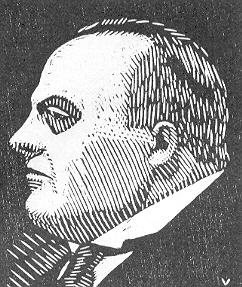
Efim Bogoljubow (woodcut by Erwin Voellmy)
Myths have grown up about the ‘FIDE champion’ affair, and in particular there are no grounds for describing Bogoljubow as ‘FIDE world champion’, a term which the Federation did not use. An overview of what happened was provided in C.N. 1967 (see pages 209-210 of Kings, Commoners and Knaves), and now we examine the matter in greater detail.
At its Congresses in 1925 and 1926 FIDE expressed a desire to become involved in the world championship, on the basis of the London Rules of 1922 (which had been signed by Capablanca, Rubinstein, Maróczy, Réti, Alekhine, Bogoljubow, Tartakower and Vidmar). FIDE accepted the Rules in principle, as a basis for the world championship being held under its auspices, but declared itself unable to provide the funds required; believing the financial provisions impracticable, it called upon Capablanca to come to an agreement with the leading masters to revise them. Below is the corresponding part of Resolution XI, which was passed at the FIDE Congress in Budapest in 1926 and appeared on pages 8-9 of the minutes:
‘L’Assemblée Générale ...
Constatant, qu’en principe, l’Assemblée Générale accepte les dispositions du protocole de Londres comme pouvant servir de base aux épreuves pour le Championnat du Monde sous les auspices de la FIDE; que toutefois la FIDE n’est pas disposée à dépenser dans ce but la somme fixée par le protocole de Londres;
Que d’ailleurs le protocole de Londres ne semble pas praticable sur ce point, et formerait un obstacle permanent à la rencontre pour l’honneur suprême des échecs;
Invite M. Raoul-José Casablanca [sic] à s’entendre avec MM. les grands Maîtres pour réviser sur ce point les conditions pour le Championnat du Monde.’
Page 5 of the 1926 minutes referred to a distinct matter: the Federation’s decision to introduce the official championship of FIDE (‘... décide d’autre part d’instituer le championnat officiel de la FIDE’), but in a report on FIDE’s Congress in London (July 1927) on pages 138-139 of the September 1927 Schweizerische Schachzeitung J.L. Ormond indicated that FIDE was biding its time over the ‘FIDE championship’ until Capablanca had played his match against Alekhine for the world championship:
‘La question du championnat de la FIDE reste en suspens, en attendant le match Capablanca-Alekhine pour le championnat du monde à Buenos Aires en septembre prochain.’
In a separate section on the same page Ormond mentioned other plans by FIDE, e.g. to hold in 1928 ‘un tournoi individuel pour le championnat amateur de la FIDE (tenant: Mattison) ouvert à un seul représentant par fédération’. The earlier such event had been held in 1924, and was called the ‘tournoi international d’amateurs à l’occasion de la VIIIe Olympiade’ in the report on pages 169-171 of the July 1924 La Stratégie.
The second tournament took place in The Hague in July and August 1928, being described on page 328 of the September 1928 BCM as ‘the second Olympic Chess Tournament’. It was won by Euwe, who thereby became ‘Olympic individual champion’, in succession to Mattison.
The Netherlands had also been the venue, a few months previously, for a match between Euwe and Bogoljubow which page 132 of the May 1928 Deutsche Schachzeitung described as being for the championship of the World Chess Federation (‘um die Meisterschaft des Weltschachbundes’). Page 238 of the June 1928 BCM commented:
‘It has been stated that this victory entitles the winner to be regarded as the official (FIDE) candidate for a challenge match with the world champion. As the FIDE annual meeting of delegates is not until August next, at the Hague, we fail to see how this can have been decided.’
Below, for the record, is the complete text in the FIDE minutes (The Hague, 1928) with respect to the ‘Championnat de la FIDE’:
‘L’A.G. [Assemblée Générale] vu les décisions des Congrès de Budapest et de Londres, approuve l’attitude du Comité Central qui a adopté le premier match Bogoljubow-Euwe comme le premier match pour le titre de Champion de la FIDE.
Le félicitant de [sa] victoire, elle reconnaît le Maître E. Bogoljubow comme le premier Champion de la FIDE.
Mr Wahltuch propose de dresser la liste réglementaire des quatre candidats pour le championnat de la FIDE (art. 5 Règlement des Epreuves).
Mais l’A.G. s’abstient pour cette année de l’établissement de cette liste, se réservant toute décision ultérieure à ce sujet.’
In short, the General Assembly approved the Central Committee’s decision to adopt the Bogoljubow v Euwe contest as the first match for the title of FIDE champion. The British delegate, Victor Wahltuch, proposed that the required list of four candidates for that title should be drawn up, but the General Assembly decided to defer the matter.
Nothing was said about Bogoljubow possibly becoming the world championship challenger by dint of his victory over Euwe.
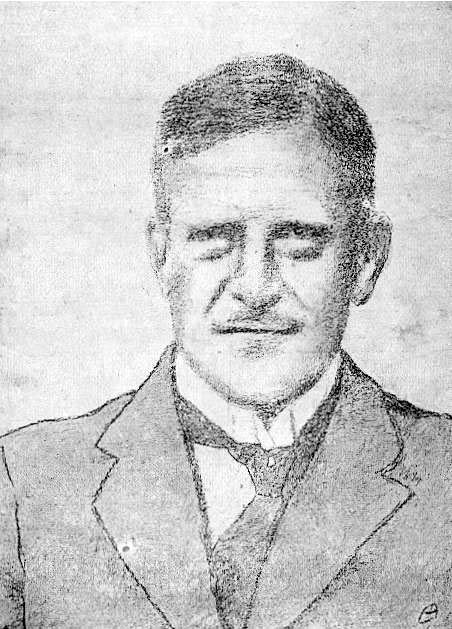
Alexander Rueb
The FIDE President, the Dutchman Alexander Rueb, was absent from the Congress in The Hague but had submitted a lengthy report dated June 1928 which included detailed background information on the genesis of the FIDE championship:
‘Entre l’institution du championnat du monde et de celui de la FIDE il y a de la connexité. Dès les commencements en 1925 l’Assemblée Générale a été d’opinion que derrière l’épreuve suprême pour le championnat du monde il pouvait y avoir dans l’enceinte de la FIDE un championnat général, de structure plus simple, mais régulier et de valeur durable.
Le paragraphe trois du Règlement des Epreuves contient la définition complète de cette institution.
Pour éviter que le Championnat de la FIDE restât lettre morte j’ai demandé et obtenu à l’Assemblée Générale de Budapest l’autorisation pour le Comité Central d’arranger le premier match pour ce championnat, ou bien, s’il se présentait un match dû à une autre initiative, d’accepter cette épreuve comme épreuve de la FIDE, si elle répondait à certaines exigences. Mes efforts en 1926 pour arranger un match entre MM. Alekhine et Bogoljubow ont rencontré des obstacles insurmontables; mais au mois d’avril de cette année s’est présentée une excellente occasion dans le match Bogoljubow-Euwe. Avec le consentement explicite de Messieurs Rees et Nicolet j’ai fait savoir aux deux concurrents, avant le commencement de la lutte, qu’avec leur consentement elle serait comptée comme une épreuve pour le championnat de la FIDE. Mon choix était fondé sur la haute considération dont jouissent les deux adversaires, et le niveau des parties jouées m’a semblé le justifier tout à fait. J’ai pu avec une sympathie particulière souhaiter la bienvenue comme premier Champion de la FIDE à Monsieur Eugène [sic] Bogoljubow, qui est sorti de la lutte avec une petite avance. C’est maintenant à l’Assemblée Générale de donner son approbation aux démarches du Comité Central et de procéder selon le règlement à la liste de quatre candidats officiels au titre.
Dans la presse et même chez des personnages officiels j’ai rencontré de l’étonnement et de l’incompréhension à propos du match Euwe-Bogoljubow, en rapport avec le titre de champion de la FIDE. La responsabilité en retombe sur moi, puisque je suis chargé de l’Administration du Bureau de la FIDE ...’
To summarize this report by Rueb: Already in 1925 the General Assembly considered that in addition to the world championship there could be, within FIDE, a general championship. In 1926 Rueb was authorized by the General Assembly to arrange the first match for the FIDE championship, or to accord that status to any suitable match organized by another party. That same year he encountered insurmountable obstacles in trying to set up a match between Alekhine and Bogoljubow, but in April 1928 an excellent opportunity arose with the Bogoljubow v Euwe match. With the agreement of two senior FIDE officials, L.P. Rees and M. Nicolet, Rueb approached Bogoljubow and Euwe in advance of their match to propose that it be played for the FIDE championship. Rueb invited the General Assembly to approve his course of action and to draw up a list of four candidates for the FIDE title. Finally, he observed that in the press, though among officials too, astonishment and incomprehension had been expressed at FIDE’s action over the Bogoljubow v Euwe match and the ‘FIDE champion’ title. As the person in charge of administering the FIDE office he assumed responsibility for what had been done.
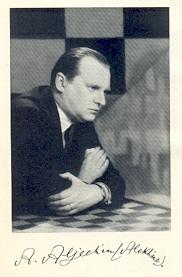
Alexander Alekhine
Alekhine, the reigning world champion, attended part of the 1928 Congress and, as recorded in the minutes, agreed to place future matches for the world title under the auspices of FIDE, although any match with Capablanca should be under the same conditions as in Buenos Aires, 1927. The General Assembly approved this position and decided to form a commission under Rueb to modify the London Rules. The following, in addition to Alekhine, would be asked to make up the commission: Pierre Vincent, Walter Robinow, Jan Bedrníček, Ossip Bernstein and Sir George Thomas.
A resolution declared that given the formation of the commission and since, furthermore, it was desired to combine the world championship and the FIDE championship in the near future, no further discussion on procedures would be undertaken at that stage. The full text of this resolution was:
‘Championnat de la FIDE
Vu qu’une commission a été nommée pour examiner les conditions à proposer pour le Championnat du Monde, et le désir d’arriver à confondre dans un prochain avenir le Championnat du Monde et le Championnat de la FIDE,
l’Assemblée Générale suspend toute discussion qui aurait dû être entreprise conformément au Règlement de la FIDE pour cette épreuve;
renonce pour la même raison à en examiner la modification, le statu quo continuant d’exister (unanimité).’
The minutes of subsequent FIDE Congresses recorded that the commission never met. In any case, by the time of the 1929 Congress in Venice, which Alekhine also attended, a world championship match was underway (neither under the auspices of FIDE nor in accordance with the London Rules) between Alekhine and Bogoljubow. No more was heard of the idea of a FIDE champion at that time.
Rueb was under great strain in 1928. The detailed report on the Congress by Erwin Voellmy on pages 137-143 of the September 1928 Schweizerische Schachzeitung referred to Rueb’s absence through serious illness, as well as his strong desire to resign as President. It is notable that Voellmy made no mention at all of the ‘FIDE championship’ matter.
To return to Kasparov’s comments in New in Chess, is it fair to assert that ‘FIDE failed to interest the champions’, given that Capablanca, Alekhine and Euwe were, at various times, all closely involved in efforts to bring the world championship title under the aegis of FIDE? As has been mentioned above, Alekhine attended the FIDE Congresses in both 1928 and 1929, but where exactly is he to be found ‘publicly scoffing at Bogoljubow’s FIDE title’?
On the other hand, Kasparov’s comment about the insignificance of the ‘FIDE champion’ title can hardly be disputed. Rueb and other FIDE officials really should have anticipated that it would prompt ‘astonishment and incomprehension’.
Who was the first player to be recognized by FIDE as world champion, and in which year?
It is frequently stated that Emanuel Lasker and Richard Teichmann were born the same day, 24 December 1868, but were they? Richard Forster (Winterthur, Switzerland) points out that when Teichmann died various obituaries in German magazines gave 23 December 1868, one example being on pages 198-199 of the July 1925 Deutsche Schachzeitung. Indeed, page 281 of Deutsches Wochenschach, 21 June 1925 specifically stated that 24 December was incorrect:
‘Teichmann war am 23. (nicht 24.) Dez. 1868 in Lehnitzsch in Sachsen-Altenburg geboren ...’
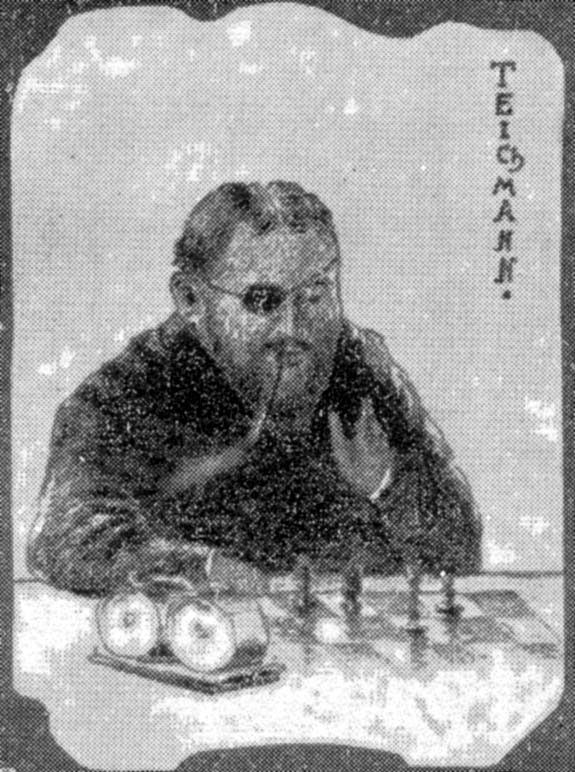
Richard Teichmann
Another group photograph, from the 1929 British Championship in Ramsgate, is added here, gleaned from page 162 of the September-October 1929 American Chess Bulletin:
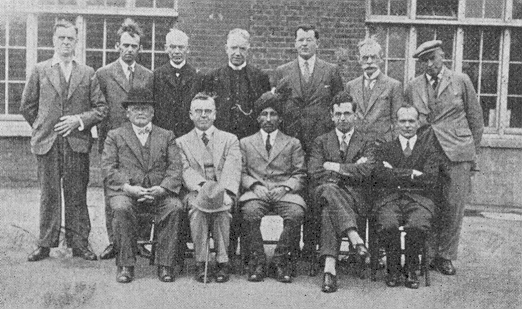
Another feature
article has been posted, on Capablanca v Bogoljubow, Moscow,
1925.
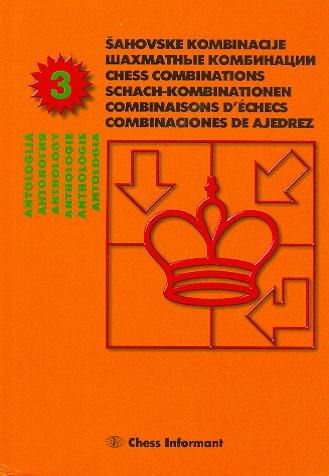
In common with its two predecessors (published in 1980 and 1995) Anthology of Chess Combinations (Belgrade, 2005) makes little effort to attach accurate names, dates or places to the combinations on display. After everything written in readily available sources, how can the Chess Informant team believe that Glucksberg v Najdorf was played in the 1935 Warsaw Olympiad? Or that there was a game ‘F. Parr – Waitkroft’ in 1968? Or that Morphy had an opponent named ‘Morian’? Or that Botvinnik’s brilliancy against Capablanca at AVRO, 1938 was played in Amsterdam?
Such a list of elementary matters could be prolonged almost endlessly, but to what effect? We would, though, draw attention to the Chess Informant’s sense of balance; in the 2,709 combinations Emanuel Lasker is featured just once (a loss) and Capablanca only twice (two losses).
Concerning the Warsaw, 1910 tournament, in C.N. 3990 John Donaldson (Berkeley, CA, USA) asked about Daniel J. Greenway, whose archives were mentioned by Jeremy Gaige in Volume IV of Chess Tournament Crosstables (Philadelphia, 1974). Now Mr Donaldson informs us:
‘A few days ago I spoke to Jeremy Gaige about Greenway. He mentioned that while there was no listing in Chess Personalia a reference to him appeared in the BCM obituaries at the back. Page 104 of the April 1961 BCM states:
“Daniel J. Greenway
President of the Argentine Chess Federation and Professor at the Buenos Aires Faculty of Medicine, Doctor Daniel J. Greenway passed away on 29 December 1960, at the early age of 56.”
Greenway died before Gaige started his research. He believes that his contact for the information was M. Lachaga, who I would assume must be no longer with us or is close to 100. If he is deceased I wonder who now has the archives of Greenway.’
A commentary on the writing career of John Nunn will be presented here shortly, following the recent publication of his book Grandmaster Chess Move by Move (London, 2005), but first we pick up his reference on page 178 to ‘the fate of players such as von Bardeleben, who are remembered today only for games they lost’.
One striking example of such a fate is R.F. Combe (1912-1952), who, well over a decade before becoming British champion, suffered the indignity of losing an ultra-brief game in the Folkestone Olympiad on 14 June 1933. Regarding that encounter with W.R. Hasenfuss page 294 of the July 1933 BCM reported:
‘The most sensational incident, in a minor way, was a four-move win for Latvia against Scotland on the last board, which is surely a tournament record. The game ran 1 P-Q4 P-QB4 2 P-Q4 [sic] PxP 3 Kt-KB3 P-K4 4 KtxKP Q-R4ch and White resigned.’
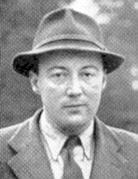
Robert Forbes Combe
Nowadays the chances are that any reference to Combe in chess literature will concern this gamelet, but it has appeared in contradictory forms. On page 22 of 1000 Best Short Games of Chess (New York, 1955) I. Chernev indicated that it was a Sicilian Defence (1 e4 c5 2 d4 cxd4), whereas on page 106 of Chess Olympiads (Budapest, 1969) A. Földeák gave 1 d4 c5 2 c4 cxd4. However, in the October 1970 CHESS, page 39, Földeák asked whether it was known for sure which moves Combe had played. Referring to the BCM’s version he wrote:
‘White’s first two moves cannot both be P-Q4. Some sources give it as 2 P-QB4, others as 2 P-K4. Both Alexander and Fairhurst think that 2 P-K4 was played, but at this distance are not quite sure.’
The magazine returned to the matter on page 71 of its November 1970 issue, quoting M.D. Thornton of Stirling (‘long a Scottish C.A. official’):
‘Combe’s game was a Sicilian (played shortly after a particularly exhausting adjournment session) i.e. White’s first move 1 P-K4 and otherwise as you gave it.’
CHESS added:
‘But the famous Belgian magazine L’Echiquier (1933, page 353) gives the first move as 1 P-Q4 – and their correspondent E. Colle was on the spot.
In view of this last circumstance, we are inclined to believe L’Echiquier.’
CHESS was unwise to place its trust in ‘this last circumstance’, given that Colle had died over a year before Combe v Hasenfuss was played.
On page 203 of the March 1971 CHESS Owen Dixson wrote:
‘I was staying in the same house at Folkestone with R.F. Combe and R.N. Coles. ...
I well remember the afternoon when Combe returned to the house a bit disconsolate after losing to the Latvian player in four moves ...
You will remember that a few years ago I began to write a book called “Chess in Kent” (it never reached the publishing stage), but I have now turned up the manuscript and found that I wrote on page 41 as follows:
“One of the most promising of Scotland’s younger players some years ago was R.F. Combe, who represented his country in the team tournament at Folkestone in 1933. At that tournament young Combe made chess history by losing his game with Hasenfuss (Latvia) in four moves. The game went: 1 P-Q4 P-QB4 2 P-QB4 PxP 3 N-KB3 P-K4 4 NxKP Q-R4ch White resigns.”
I can vouch for this being the correct score.
“Although I did not happen to be present in the Leas Cliff Hall when this Scottish disaster took place, I was shown the game by Combe himself later in the day. As he cheerfully played over the moves on his pocket set he explained that he could, of course, have continued the game – some people thought he should have done so – but defeat would have been inevitable against a player of the calibre of Hasenfuss.
Combe’s health at that time was poor, and he later became so ill that he was obliged to drop out of big chess, leaving the field clear for those other fine Scottish players, Fairhurst and Aitken. Later, of course, he was to make a fine ‘come-back’ and win the British Championship.”’
CHESS commented:
‘It seems to us that this is closer to absolute certainty than we could have hoped to get.’
It did not, though, put an end to the confusion. On page 44 of the January 1973 BCM R.N. Coles wrote:
‘I was staying at the same hotel in Folkestone as Combe in 1933, and I recall his showing me the game afterwards; the opening move was neither P-Q4 nor P-K4 but 1 P-QB4, and then 1...P-QB4 2 P-Q4. It was the fact that it was an irregular opening and not a Sicilian that lured Combe into his ghastly error.’
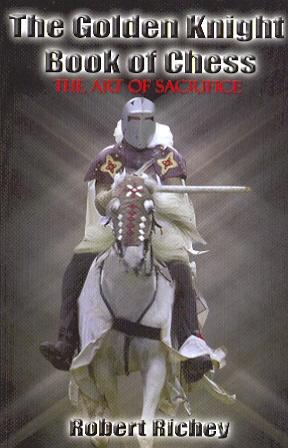
For the benefit of readers who prudently refrain from acquiring The Golden Knight Book of Chess by Robert Richey (Bloomington, 2005), two passages are quoted below. The first, from page xi, is part of the author’s explanation of the history of chess and some other games, such as golf and football. Regarding the latter he writes:
‘There is evidence to believe that Football it’s inception back in 1670 A.D. in Ireland. Therefore it has been around the about 334 years.’
On page 151 the solution to a chess puzzle begins with some golden advice:
‘Yet another seeming hopeless position. This is why in Chess to always analyse even in desperate circumstances for there are many time when the opponent poses the greatest threat at the same time may be the most vulnerable.’
From Bradley J. Willis (Edmonton, Canada):
‘I have a book of poetry entitled Chess Pieces by David Solway, published in 1999 by McGill-Queen’s University Press. It consists entirely of poems somehow referring to chess. I confess most of it seems pretty poor stuff to me, but it has a laudatory blurb by the considerable American poet Richard Wilbur, to whom one must, I suppose, defer. Solway is rather well-known in Canada, perhaps more as an acerbic literary critic than for his poetry.
What interests me is that the book is dedicated in part to “Robert Hübner, magister ludi”, and there is a poem (on pages 49-50) entitled “My Game with Robert Hübner”. In it the author refers (curiously, since he is seven years older than Hübner) to “Old Hübner” as having “judging me a dunce / kindly offered to play me once”, evidently a casual game. He then claims to have outplayed Hübner, who, in a lost position, offered a draw “to which from kindness I agreed / since even masters, pricked, will bleed”. I detect no irony. The author seems really to be claiming to have outplayed Hübner.
My problem is that the language Mr Solway uses in referring to chess elsewhere in the book sounds odd coming from a player strong enough to hold Hübner to a draw even in a casual game. For example, in “My Own Chess”, on pages 45-46, he says that “a poor start is my prerequisite”, and gives odd examples, including the “embarrassment of double-check / before I’ve slid a single bishop out” – after which he claims that he then usually begins to play well and in the “accustomed strife / my once-benighted game comes back to life”. It sounds rather like he lost his queen as Black on the sixth move of the old trap in the Petroff. I cannot think of any normal opening line in which one could have a salvageable game after being on the receiving end of a double-check before one’s bishop is out.
My questions are:
1. When and where was the game against Hübner played? (It may be relevant that another poem, “The Tournament” on pages 17-18, mentions Hübner and concerns the 1979 Montreal tournament, although of course that makes the reference to “Old Hübner”, who was then only 30, even odder.)
2. Is Solway’s account of the game with Hübner fact or fiction?
I have been unable to find a review of the book by anybody not a self-confessed patzer. In Books in Canada there was a long review by one Carmine Starnino, but the first paragraph contains the painful solecism “a game rooted in the combative grit of moments like ‘White plays Queen to Rook’ doesn’t sound like an especially accessible resource for song”, which to me rather devalues the highly laudatory analysis that follows.
I should be grateful for any light that can be shed on this intriguing literary puzzle.’
This illustration appeared on page 313 of Harper’s Bazar, 20 May 1882:
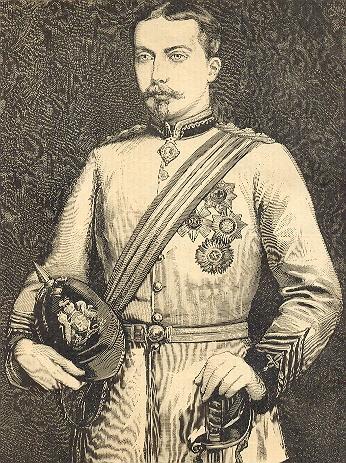
Prince Leopold, Duke of Albany
Below is the acrostic poem by Mrs T.B. Rowland referred to in C.N. 4044:
Tears now we sadly shed apart,
How keenly has death’s sudden dart
E’en pierced a kingdom’s loyal heart.Dark lies the heavy gloomy pall
Upon our royal bower,
Kings, queens, and nations bow their heads,
Each mourn for England’s flower.Oh! God, to her speak peace divine,
For now no voice can soothe but thine.Ah, why untimely snatched away,
Loved Prince – alas, we sigh –
Before thy sun its zenith reached
Athwart the noonday sky.
Noble in heart, in deed, and will,
Years hence thy name we’ll cherish still.
That poem was published on pages 140-141 of Chess Fruits, and page 141 had the following acrostic composition, also by Mrs T.B. Rowland:
Paled e’er that light once bright,
A pleiad passed away
Unrivalled star, afar,
Lost to our sight for aye.Midst wondering gaze, thy blaze
Of glory charmed our eyes,
Rest, Morphy rest – now blest,
Peace o’er thy spirit lies.
Hushed every grief – each care has fled,
Yet still for thee fond tears are shed.
From Edward Hamelrath (Dresden, Germany):
Although no additional biographical information comes to mind at this stage, our correspondent’s contribution is an opportunity to raise a point regarding Capablanca’s non-participation in Hamburg, 1910. In chapter IV of My Chess Career (page numbers vary, according to the edition) he wrote:‘Since reading your book on Capablanca I have become very curious about why he did not play in more major chess tournaments, especially during the period 1911-12, when there were so many great events.’
‘In the summer of 1910 I was invited to take part in the International Tournament at Hamburg. I accepted the invitation, and was ready to start when my physical condition prevented my making the voyage to enter such a strenuous contest. Many comments were made at the time with respect to my withdrawal at the last hour, some of the masters making the silly remark that I had simply been scared away by the strong entry of the tournament. The real reason was, as I have already stated, that I was not in condition to stand such a strain. That I was not afraid, and had no reason to be, I soon proved to the satisfaction of all, when the following year I won the first prize in the strongest tournament that has ever been held: the first San Sebastian tournament.’
Magazines of the time referred to Capablanca’s intended participation in Hamburg, 1910 and to his withdrawal through illness. But what critical comments were made, and which masters accused him of being ‘scared away’?
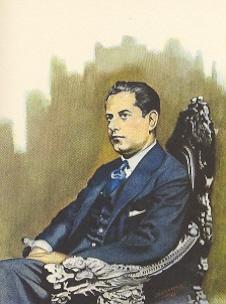
José Raúl Capablanca
Many books state that Capablanca studied a thousand rook and pawn endings. The meaning of this in concrete terms is unclear, but what is the source of the story?
From Mark N. Taylor (Mt Berry, GA, USA):
‘A few comments on inaccuracies in the December 1915 American Chess Bulletin report on the van Mander painting:
“The mediaeval shapes”: the shapes are not medieval at all, even granting the wide variety of medieval chess pieces.
“The same designed bishops are given in the diagrams of the Alfonso Spanish 1283 Manuscript”: the bishops are not at all similar. In the Alfonso MS they resemble an old coffee pot. A modern font modelled on their design may be seen at Sonja Musser Golladay’s website.
“The double-headed rook appears in Caxton’s London 1480 edition”: this piece does resemble the older style rather than the more modern tower, but does not appear to be bifurcated as medieval rooks (including Caxton’s) usually are. These may be easily compared with those pieces pictured in Murray or the better coffee-table books on chess pieces.
More nonsense in the May 1916 Chess Amateur on “Shakespeare’s genuine death mask”; there is no such thing and there is no telling what the author is referring to.
A general remark: perhaps some 90% of what appears in most biographies of Shakespeare consists of legend, conjecture, and fancy – we have so few facts – so it is no surprise that most of what is written on Shakespeare and chess is mostly fancy. S. Schoenbaum, the author of the only truly reliable biography, William Shakespeare: A Documentary Life, ignores both the van Mander painting and the “death mask”.’
C.N. 3398 referred to the graves of McDonnell and Labourdonnais at Kensal Green Cemetery, London. Here we add that the only photographs known to us were published on page 202 of “Our Folder” (The Good Companion Chess Problem Club) 1 May 1921:
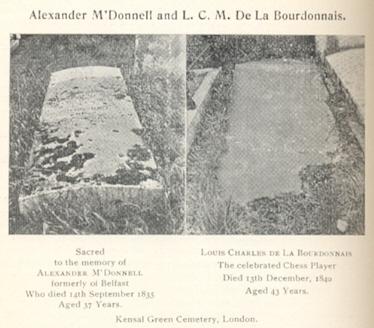
For ease of reference, a factfinder index page has been prepared concerning our books Chess Explorations, Kings, Commoners and Knaves, A Chess Omnibus and Chess Facts and Fables.
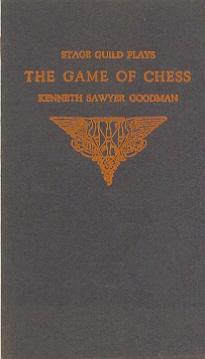
A play (one act) which is seldom mentioned nowadays is The Game of Chess by Kenneth Sawyer Goodman, first produced in Chicago on 18 November 1913. It is a struggle to find anything worth quoting from it, and we make do with the following exchange:
‘Constantine: Your excellency tires of the game, perhaps?
Alexis Alexandrovitch: No, I never tire of the game. When I do that, I shall tire of life itself.’
It cannot have taken too much imagination to adapt Samuel Johnson’s celebrated remark (recorded by James Boswell in The Life of Samuel Johnson), ‘When a man is tired of London, he is tired of life.’
Is Alekhine the only master to have been the subject of a play and a film?
The play, Knight of the ID by Richard Laurie, was set in Portugal in 1946 and had its première in August 1997.
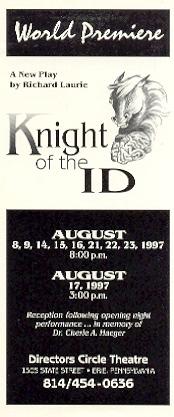
The film, The White Snow of Russia, was a 1980 Soviet production written by Kotov, with Aleksandr Mikhailov as Alekhine. Below are three photographs, taken from pages 44-47 of the 4/1982 Boletín Ajedrez Radio Rebelde (an article by Natalia Lazareva which had appeared in the August 1980 issue of a publication identified by the Cuban magazine as Films Soviéticos):
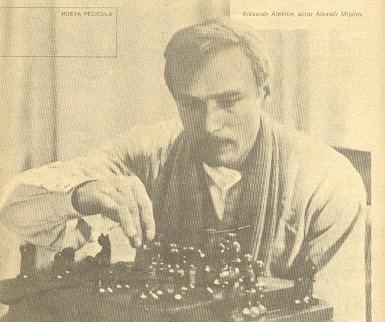
Aleksandr Mikhailov as Alekhine
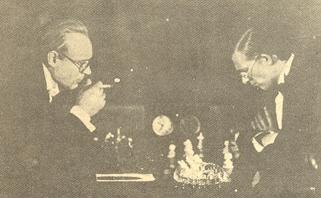
‘La Partida decisiva por el Campeonato Mundial’
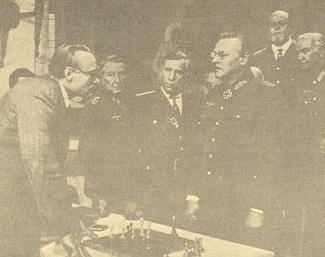
‘La Segunda Guerra Mundial. Praga. Una simultánea’
C.N. 3977 commented: ‘A quote vaguely ascribed to Alekhine (e.g. on the Internet) is “combination is the soul of chess”. Whether he ever made such a remark we cannot say ...’ That remains the case, but we have now found the following on page 29 of Das Internationale Schachmeisterturnier in Budapest 1896 by G. Maróczy (Kecskemét, 1941):
‘Kombination ist die Seele des Spieles.’
This remark appeared at the end of the annotations to Tarrasch v Albin, and the book’s introduction (pages 6-7) indicates that those notes were written by Charousek. Further information is being sought.
Chess Notes Archives:
| First column | << previous | Archives [17] | next >> | Current column |
Copyright 2005 Edward Winter. All rights reserved.